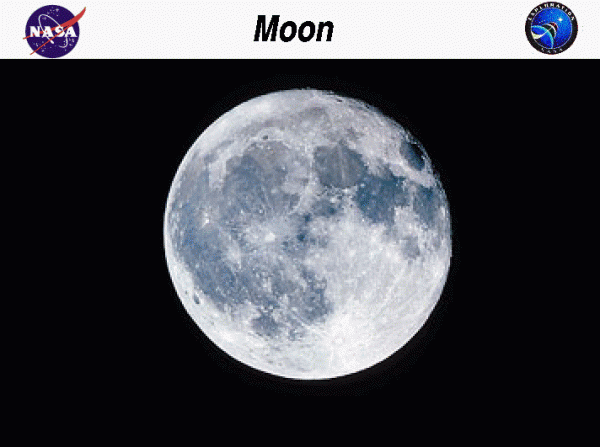Moon

Moon
The Moon is Earth’s nearest neighbor. It orbits the Earth at an average distance of approximately 240,000 miles (384,000 km). The Moon completes an orbit of the Earth every 27.3 days (approximately 655 hours). The Moon also rotates on its axis. Because of tidal forces, it completes one revolution every 655 hours. So, one “side” of the Moon is always facing the Earth, and the other “side” is always facing away from the Earth. On the surface of the Moon, you would experience 327.5 hours of sunlight and 327.5 hours of darkness. If you lived on the side of the Moon facing the Earth, you would always see the Earth in the same location in the sky, although the stars and Sun would move across the sky. If you lived on the side of the Moon facing away from the Earth, you would never see the Earth, although you would see all the stars and the Sun.
Moon’s Formation
At the time of its formation, the Moon had a liquid core and experienced flows of lava which created the flat basins, or “mare’s”, which we see from Earth. The Moon gradually cooled, forming a thick crust. We see no evidence of plate tectonics, as we have on Earth, so the surface material on the Moon has remained nearly the same for more than 3 billion years. Because of the lack of an atmosphere, the Moon’s surface has been bombarded by passing debris, creating many, many impact craters. The mass of the Moon is approximately 8.1 x 1019 tons (7.3 x 1022 kg or .01 x Earth mass). The mean diameter of the Moon is 2,159 miles (3,476 km or .27 x Earth diameter).
The mass of the Moon is not evenly distributed; mass concentrations, called Mascons, lie beneath many of the lunar basins, and the center of mass of the Moon is displaced several kilometers towards the Earth. The non-uniform mass distribution creates orbital stability problems for spacecraft orbiting the Moon.
The average surface gravitational acceleration (gmn) of the Moon is given by:
\(\LARGE \mathit{gmn}=5.3\frac{\text{ft}}{\text{sec}^{2}}=1.62\frac{\text{m}}{\text{sec}^{2}}=.165\text{ Earth gravity}\)
Atmosphere of Moon
The Moon has no appreciable atmosphere. The sky is always black and the radiation from the Sun strikes with full force on the surface of the Moon. The lack of atmosphere produces temperature extremes on the Moon that range from -250 degrees F in the dark to +250 degrees F in the light. Because of the lack of atmosphere, and high radiation environment, there are no living organisms on the Moon. The lack of atmosphere means that there is no aerodynamic drag on a rocket leaving the surface of the Moon, but it also means that a landing spacecraft cannot use aerodynamic braking and must use rocket propulsion to land on the surface.
Robotic Race to the Moon
Robotic exploration of the Moon began in the early 1960’s by both the United States and the Soviet Union. Of particular note, the American Ranger spacecraft returned detailed pictures of the Moon as the spacecraft were crashed into the surface. The Ranger project was followed by the soft-landing Surveyor spacecraft that performed a number of experiments on the lunar soil as well as photographic investigations from the surface. The Lunar Orbiter spacecraft produced photographic maps of the surface of the Moon that were used to select landing locations for the Apollo program. The Soviets also soft landed on the Moon as part of the Lunik (Luna) program. A lunar rover (Lunokhod) and a sample return mission were also successfully executed by the Soviet Union.
Human Race to the Moon
Human exploration of the Moon was begun by the United States during the Apollo program. Apollo 8 and Apollo 10 orbited the Moon without landing astronauts on the surface. Six Apollo missions (11, 12, 14, 15, 16, & 17) each landed two astronauts on the surface of the Moon. The last three missions included an electric-powered “buggy” which allowed the astronauts to explore several kilometers around the landing location. All of the missions returned lunar rocks and soil to the Earth and established research stations that continued to return data after the astronauts left the surface. Apollo 13 experienced an explosion on the way to the Moon. The spacecraft swung around the Moon and safely returned the crew to the Earth.
